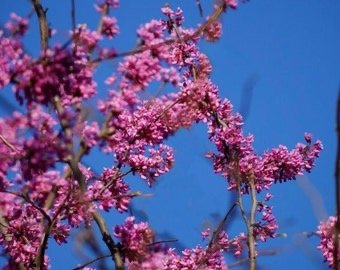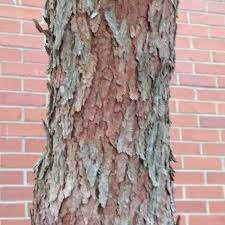
Eastern Redbud
Eastern Redbud
Botanical Name: Cercis canadensisFamily Name: Fabaceae - Legumes familyOrigin: Eastern N. AmericaThe Eastern Redbud, Cercis canadensis, is a large deciduous shrub or small tree native to eastern North America from southern Michigan south to central Mexico, and east to New Jersey. It is a popular tree in parks and gardens. In the wild, you’ll see it as an understory tree in mixed forests. The eastern redbud is the Oklahoma state tree.
At Dodona, we have a row of 3 eastern redbuds in the front yard and two redbuds on the east side and one in the backyard. All were planted since the museum opened in 2005.
The eastern redbud typically grows 20 to 30 feet tall with a spread of 26 to 33 feet wide. It generally has a short, often twisted trunk and spreading branches. The bark is dark in color, smooth, and then later scaly with ridges and sometimes with maroon patches. The tree has slender twigs that often zigzag and are nearly black in color. The leaves are alternate, simple, and heart-shaped 3 to 4.5 inches long and wide. When full-grown, the leaves are smooth and dark green above and paler beneath (underside). In autumn, they turn bright clear yellow.
The eastern redbud gets its name from its distinctive flowers. The flowers are light to dark magenta pink and appear in clusters from spring to early summer. The flowers appear on bare stems before the leaves sprout. The flowers can even appear on the trunk too. The flowers are pollinated by long-tongued bees such as blueberry bees and carpenter bees. Short-tongued bees cannot reach the nectar.
The flowers can be eaten fresh or fried. In some parts of Appalachia, green twigs from the eastern redbud are used as seasoning for wild game such as venison and opossum. In these mountain areas the eastern redbud is sometimes known as the Spicewood tree.
The wood is dark reddish-brown, heavy, hard, and coarse grained. The wood is not strong. It burns a steady low heat, much like oak. The wood can be used for gunstocks, knife handles, decorative bowls, and veneers.
Medicinal & Nutritive Uses
The inner bark is highly astringent and can be made into a tea to treat fevers, diarrhea, and influenza. Native Americans ate the flowers raw or cooked (you can too!) as well as the young seed pods and seeds raw or cooked. The flowers are high in vitamin C and look pretty in a salad. They can be pickled and used like capers.
Folklore
The Redbud tree is known in many parts of the world as the tree on which Judas Iscariot hung himself on after betraying Jesus for thirty pieces of gold.
Legend says that before the crucifixion of Christ, the Redbud (actually an Old World relative) grew tall and strong as an oak, but afterward, in shame, the tree shrunk in size and its white blossoms turned purple, also out of shame but also symbolic of the blood that was shed It is thought that restless spirits gather under redbuds at night and so one should not venture into them at night.

